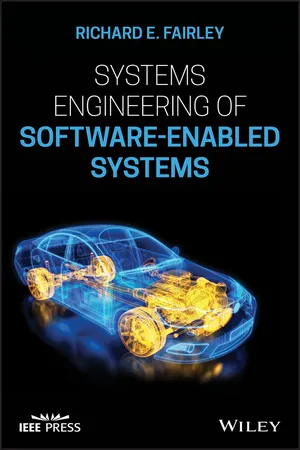
- English
- ePUB (mobile friendly)
- Available on iOS & Android
Systems Engineering of Software-Enabled Systems
About This Book
A comprehensive review of the life cycle processes, methods, and techniques used to develop and modify software-enabled systems
Systems Engineering of Software-Enabled Systems offers an authoritative review of the most current methods and techniques that can improve the links between systems engineering and software engineering. The author—a noted expert on the topic—offers an introduction to systems engineering and software engineering and presents the issues caused by the differences between the two during development process. The book reviews the traditional approaches used by systems engineers and software engineers and explores how they differ.
The book presents an approach to developing software-enabled systems that integrates the incremental approach used by systems engineers and the iterative approach used by software engineers. This unique approach is based on developing system capabilities that will provide the features, behaviors, and quality attributes needed by stakeholders, based on model-based system architecture. In addition, the author covers the management activities that a systems engineer or software engineer must engage in to manage and lead the technical work to be done. This important book:
- Offers an approach to improving the process of working with systems engineers and software engineers
- Contains information on the planning and estimating, measuring and controlling, managing risk, and organizing and leading systems engineering teams
- Includes a discussion of the key points of each chapter and exercises for review
- Suggests numerous references that provide additional readings for development of software-enabled physical systems
- Provides two case studies as running examples throughout the text
Written for advanced undergraduates, graduate students, and practitioners, Systems Engineering of Software-Enabled Systems offers a comprehensive resource to the traditional and current techniques that can improve the links between systems engineering and software engineering.
Frequently asked questions
Information
Part I
Systems Engineering and Software Engineering
1
Introduction and Overview
1.1 Introduction
SwE and SE are not just allied disciplines, they are intimately intertwined. Most functionality of commercial and government systems is now implemented in software, and software plays a prominent, or dominant role in differentiating competing systems in the marketplace. Software is usually prominent in modern systems architectures and is often the “glue” for integrating complex system components.(SEBoKwiki.org, Part 1, Systems Engineering and Other Disciplines)
- The evolution of engineering;
- The nature of systems, SE, and software engineering;
- Related disciplines;
- The product, service, enterprise, and systems of systems (SoSs) perspectives; and
- The roles played by PhSEs and SwSEs in developing SESs.
1.2 The Evolution of Engineering

Table of contents
- Cover
- Table of Contents
- Preface
- Part I: Systems Engineering and Software Engineering
- Part II: Systems Engineering for Software‐Enabled Physical Systems
- Part III: Technical Management of Systems Engineering
- Appendix A: The Northwest Hydroelectric System
- Appendix B: Automobile Embedded Real‐Time Systems
- Glossary of Terms
- Index
- End User License Agreement